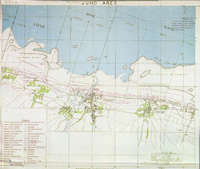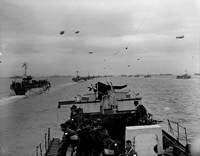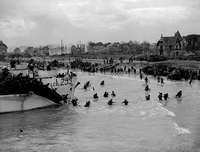|
At the end of D-Day, the canadians can be glad of the success
of the landing. Their troops are strongly dug-in on a line running between Creully,
Pierrepont and Colomby-sur-Thaon, 8 kilometers inland.
The 7th brigade linked
up with the british from Gold at Creully and a sherman troop of the 1st Hussars
pushed to Secqueville, on the RN 13 before turning back.
To
the east, the junction with the troops coming from Sword can't be made because
of the counter-attack of the 192nd Panzer Grenadier Regiment that reaches the
sea between Lion sur Mer and Luc sur Mer, but without further effect.
Caen-Carpiquet
airfield, one of the day's objectives, won't be captured until early July.
On
the canadian beaches, 3,200 vehicles and 2,500 tons of materiel have been landed.
Losses are 946 killed, wounded and missiong on a total of 15,000 men engaged.
| 




